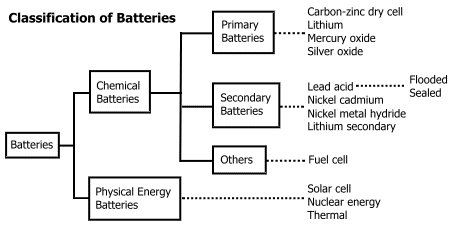
| Topics | ||||||
|
||||||

| Brand | Model | Size LxWxH inches |
Capacity Ah |
Weight lbs |
Plate type | Electrolyte |
|---|---|---|---|---|---|---|
| Power Sonic | PS-12180 | 7.13 x 3.00 x 6.59 | 18 | 13.1 | lead-calcium | absorbed |
| Hawker Energy | G16EP | 7.15 x 3.01 x 6.65 | 16 | 13.5 | lead-tin | absorbed |
| MK Battery | ES 17-12 | 7.13 x 2.99 x 6.57 | 18 | 14.0 | lead-calcium | gelled |
| Panasonic | LC-RD1217AP | 7.13 x 3.00 x 6.58 | 17 | 14.3 | lead-calcium | absorbed |
| Odyssey | PC 680 | 7.27 x 3.12 x 6.67 | 16 | 15.0 | lead-tin | absorbed |
| If you decide that a battery like the Dyna-Batt is the right battery for you, then consider purchasing the Genesis G16EP or Odyssey PC 680. Peformance Distributors sells the Dyna-Batt at a price ($132 to $155) that is much higher than the list price for the G16EP, which is about $90. The G16EP is available at the discount price of $70 from Portable Power Systems (PPS). PPS also has SAE terminals custom manufactured for Hawker batteries (see their SAE Terminal Kit, part number 30Z101B1, for $11.95). They are identical to those found on the Odyssey line of batteries. SAE terminals for Hawker/Odyssey/Genesis batteries can also be purchased at Battery Mart. The Odyssey PC 680 also suffers from price gouging, often selling at $115 to $145. Battery Mart offers very reasonable prices on a variety of batteries and accessories, including the PC 680 for $86, the PC 925MJT for $106, and the PC 1200MJT for $146. For other reasons to avoid buying the Dyna-Batt, please read the Battery Care section below. |
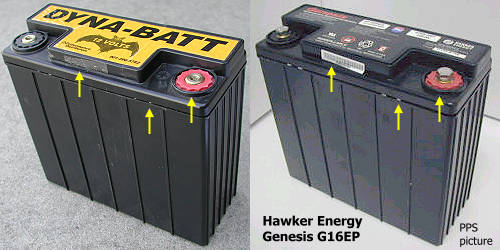
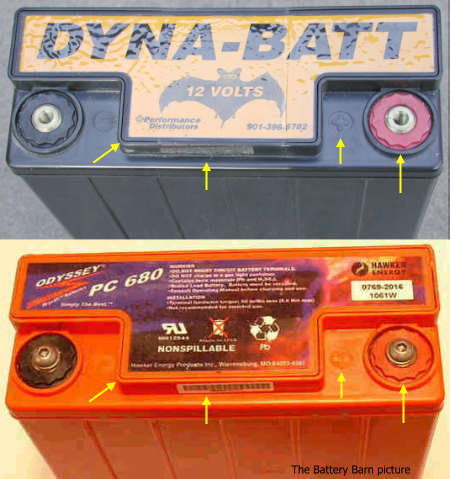
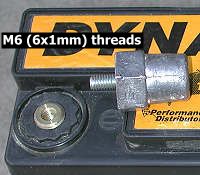
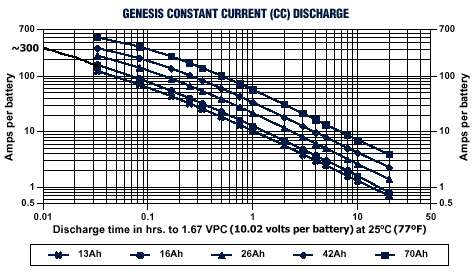
| Genesis G16EP / Odyssey PC 680 | ||
|---|---|---|
| to 7.2 V | to 10.02 V | |
| PCA 5 sec | 680 | 510 |
| PCA 10 sec | 595 | 446 |
| PCA 20 sec | 525 | 394 |
| HCA | 440 | 303 |
| CA | 360 | 270 |
| CCA | 280 | 210 |
| Run time to 10.02 v | 2 min | 5 min | 10 min | 15 min | 20 min | 30 min | 45 min | 1 hr | 2 hr | 3 hr | 4 hr | 5 hr | 8 hr | 10 hr | 20 hr |
|---|---|---|---|---|---|---|---|---|---|---|---|---|---|---|---|
| Amps | 161.2 | 90.0 | 54.8 | 40.1 | 32.0 | 23.0 | 16.3 | 12.7 | 6.9 | 4.8 | 3.7 | 3.0 | 2.0 | 1.6 | 0.8 |
| Capacity (Ah) |
5.4 | 7.5 | 9.1 | 10.0 | 10.7 | 11.5 | 12.2 | 12.7 | 13.8 | 14.4 | 14.8 | 15.0 | 16.0 | 16.0 | 16.0 |
| Run time to 11.10 v | 2 min | 5 min | 10 min | 15 min | 20 min | 30 min | 45 min | 1 hr | 2 hr | 3 hr | 4 hr | 5 hr | 8 hr | 10 hr | 20 hr |
|---|---|---|---|---|---|---|---|---|---|---|---|---|---|---|---|
| Amps | 113.2 | 72.9 | 47.6 | 36.0 | 29.1 | 21.3 | 15.3 | 12.0 | 6.6 | 4.6 | 3.5 | 2.9 | 1.9 | 1.5 | 0.8 |
| Capacity (Ah) |
3.8 | 6.1 | 7.9 | 9.0 | 9.7 | 10.65 | 11.5 | 12.0 | 13.2 | 13.8 | 140 | 14.5 | 15.2 | 15.0 | 16.0 |
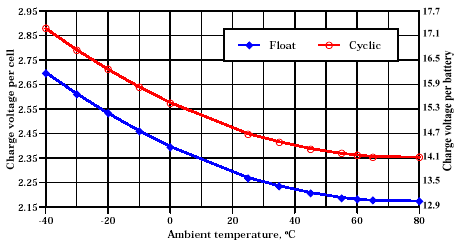
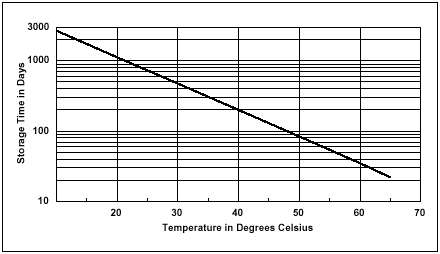
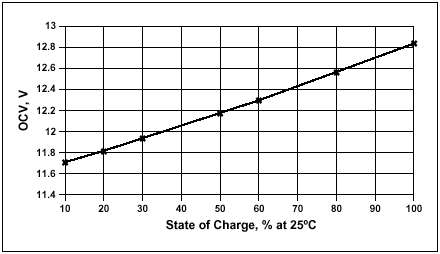
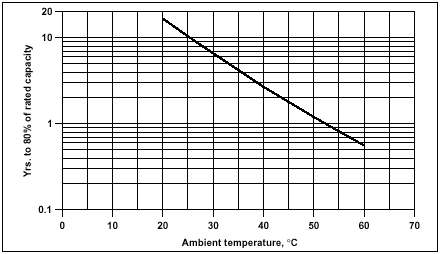
| 3000GT/Stealth Alternator | Hawker Genesis | ||
|---|---|---|---|
| Temperature | Regulated Voltage |
CV Cyclic Optimal Charging Voltage |
CV Float Optimal Charging Voltage |
| -20ºC (-4ºF) | 14.2-15.4 | ~16.3 | ~15.2 |
| 20ºC (68ºF) | 13.9-14.9 | ~14.8 | ~13.8 |
| 60ºC (140ºF) | 13.4-14.6 | ~14.2 | ~13.1 |
| 80ºC (176ºF) | 13.1-14.5 | ~14.1 | ~13.0 |
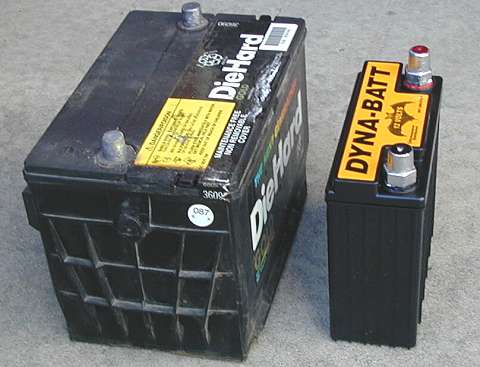
| Mitsubishi 3000GT / Dodge Stealth Stock Battery | ||
|---|---|---|
| Up to 1993 models | From 1994 models | |
| Battery type | 75D26R-MF | 75D23R-MF |
| Ah (5 hr) | 52 | 52 |
| CCA | 490 | 520 |
| Reserv. cap (min) | 123 | 118 |
| Load test (amps) | 240 | 240 |
| Brand | Model | Size LxWxH inches |
Weight lbs |
CCA | Reserve minutes |
Capacity Ah (20 hr) |
Price |
|---|---|---|---|---|---|---|---|
| Braille | B14115 | 5.80 x 3.32 x 5.88 | 11.5 | 360 | - | 15 | $175 |
| Universal | UB12180 | 7.13 x 2.99 x 6.57 | 13.5 | ~280 | - | 18 | $20 |
| Genesis | G16EP | 7.15 x 3.01 x 6.65 | 13.5 | 280 | 28 | 16 | $70 |
| Odyssey | PC 680 | 7.27 x 3.12 x 6.67 | 15.0 | 280 | 28 | 16 | $77 |
| SVR | SVR28-12 | 6.88 x 6.50 x 4.88 | 23.0 | 600* | 40 | 28 | $74 |
| Genesis | G26EP | 6.57 x 6.92 x 4.96 | 23.0 | 470 | 53 | 28 | $123 |
| Odyssey | PC 925 | 6.69 x 7.05 x 5.04 | 26.0 | 470 | 53 | 28 | $106 |
| Universal | UB12350 | 7.71 x 5.16 x 7.25 | 24.0 | - | - | 34 | $37 |
| SVR | SVR33-12 | 7.75 x 5.00 x 7.25 | 26.0 | 500 | 45 | 33 | $66 |
| Optima | Yellow Top 51 | 9.25 x 5.00 x 9.00 | 26.0 | 500 | 70 | 41 | $115 |
| AC Delco | 75P-7YR | 9.50 x 7.10 x 7.30 | 32.8 | 550 | 80 | ~40 | $100 |
| Genesis | G42EP | 7.78 x 6.53 x 6.72 | 32.9 | 630 | 91 | 46 | $??? |
| Odyssey | PC 1200 | 7.87 x 6.66 x 7.55 | 35.4 | 630 | 91 | 46 | $149 |
| Optima | Red Top 75/35 | 9.31 x 6.81 x 7.63 | 33.1 | 650 | 90 | 44 | $100 |
| AC Delco | 34P-7YR | 10.3 x 6.80 x 7.80 | 37.7 | 650 | 95 | ~48 | $100 |
| Exide | Select Orbital 75 | 9.00 x 7.00 x 7.44 | 36.0 | 690 | 80 | 45 | ~$130 |
| Optima | Red Top 34/78 | 10.0 x 6.88 x 7.81 | 38.8 | 750 | 104 | 55 | $125 |
| Exide | Select Orbital 78 | 10.1 x 7.00 x 8.1 | 38.0 | 770 | 95 | 50 | ~$140 |
| AC Delco | 65P-7YR | 11.9 x 7.50 x 7.60 | 45.6 | 800 | 130 | ~65 | $100 |
| SVR | SVR80-12 | 10.6 x 6.50 x 6.25 | 57.0 | 800 | 150 | 80 | $111 |
| Odyssey | PC 1700 | 13.02 x 6.62 x 7.68 | 58.7 | 930 | 156 | 78 | $199 |
| * the CCA for these SVR batteries seems out of line with other capacities. | |||||||
| 1st Optima Battery Sales | Optima |
| The Alternative Energy Store | Universal (Very low prices!) |
| Bargain Brothers Electronics | Optima (Very low prices!) |
| Batteriesareus.com/ | Optima |
| Battery Mart | Odyssey (Great prices. Great customer service!) |
| BatteryStuff.com | Optima |
| BatteryWeb.com | AC Delco, Hawker, Odyssey, Optima, Panasonic, Power Sonic, Yuasa |
| Portable Power Systems | Hawker, Panasonic, Power Sonic, plus SAE terminals for Hawker batteries (Great prices. Great customer service!) |
| The Battery Station | Power Sonic, Yuasa |
| Remy Battery | Optima |
| ThunderStruck Motors | Optima, Genesis ($49 for G16EP) |
| West Coast Batteries | Odyssey (plus hold downs!) |
| Wholesale Audio | SVR |
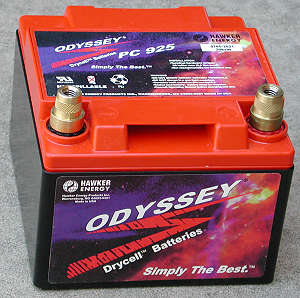
|
In consideration of the last point above, which is strongly emphasized in the Odyssey Owner's Manual, I have peeled back a very small amount of the corner of the Dyna-Batt decal to find that the Hawker Energy decal was removed. This may explain why I have heard several reports of owners having Dyna-Batt batteries that have failed. The decal may be part of the vented and sealed design or the manual may be referring to the plastic itself that the decal adheres to (I am not sure). Because there is no way to replenish lost water in the battery, any venting of water vapor, oxygen, or hydrogen, will reduce battery life. In the Odyssey Owner's Manual, Hawker Energy even says "REMOVING THE LABELED COVER" ... "WILL VOID YOUR WARRANTY". The other two actions that will void the Odyssey warranty, which is full replacement if it fails within 3 years of automotive use (2 years for motorcycle use), is exposing the battery to gasoline or diesel fuel or removing or destroying the battery's date code. This date code is removed on the Dyna-Batt. I have an Odyssey Owner's Manual because I bought a PC 925 to replace the Dyna-Batt when I moved the battery to the rear compartment (2-battery-move.htm).
Performance Distributors also does not provide any information about charging the Dyna-Batt other than saying "don't overcharge it". I suspect many owners are using standard automotive-type battery chargers that may exceed 15 volts and therefore reduce battery life. Charging voltage should not exceed 15 volts unless the battery internal temperature is below 10ºC (50ºF). See the temperature-compensated charging chart above. If the exorbitant price tag is not enough to dissuade prospective buyers from the Dyna-Batt, the warranty violations and complete lack of instructions for proper care should convince them not to purchase the Dyna-Batt from Performance Distributors. |
| Back | Home | Forward |